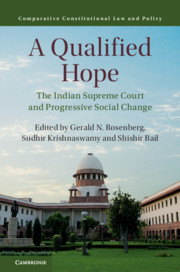Book contents
- A Qualified Hope
- Comparative Constitutional Law and Policy
- A Qualified Hope
- Copyright page
- Contents
- Notes on Contributors
- Foreword
- Acknowledgments
- Introduction
- Part I The Supreme Court of India – An Institutional Overview
- Part II The Supreme Court of India, Social and Political Mobilization
- Part III Welfare Rights and the Environment
- Part IV Discrimination
- Conclusion
- References
Introduction
The Indian Supreme Court and Progressive Social Change
Published online by Cambridge University Press: 19 August 2019
- A Qualified Hope
- Comparative Constitutional Law and Policy
- A Qualified Hope
- Copyright page
- Contents
- Notes on Contributors
- Foreword
- Acknowledgments
- Introduction
- Part I The Supreme Court of India – An Institutional Overview
- Part II The Supreme Court of India, Social and Political Mobilization
- Part III Welfare Rights and the Environment
- Part IV Discrimination
- Conclusion
- References
Summary
There is a widely held belief among Indian academics, political and civil society activists, and public-spirited citizens that the Indian Supreme Court is both capable and uniquely structured to help the relatively disadvantaged. The broad scope of rights granted by the Indian Constitution and the relative institutional independence of the Indian Supreme Court bolster this optimistic view of the Court.1 This view also draws support from the perceived inability of the Indian political system to respond to chronic denials of human rights. Political infighting, corruption, inert bureaucracies, and an ossified yet resilient cultural system render the political system structurally incapable of decisive and progressive social change. In contrast, the Indian Supreme Court is free from these constraints.
Information
- Type
- Chapter
- Information
- A Qualified HopeThe Indian Supreme Court and Progressive Social Change, pp. 1 - 20Publisher: Cambridge University PressPrint publication year: 2019
